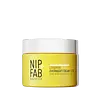What's inside
What's inside
 Key Ingredients
Key Ingredients

 Benefits
Benefits

 Concerns
Concerns

 Ingredients Side-by-side
Ingredients Side-by-side

Aloe Barbadensis Leaf Juice
Skin ConditioningSqualane
EmollientGlycerin
HumectantOvum Oil
EmollientButyrospermum Parkii Butter
Skin ConditioningCandelilla Cera
EmollientButter
Skin ConditioningBisabolol
MaskingPolyhydroxystearic Acid
EmulsifyingPunica Granatum Sterols
Skin ConditioningAloe Barbadensis Leaf Extract
EmollientRetinol
Skin ConditioningLecithin
EmollientBeta-Glucan
Skin ConditioningCeramide As
Skin ConditioningAnthemis Nobilis Flower Oil
MaskingAstaxanthin
Skin ConditioningGossypium Herbaceum Seed Oil
Skin ConditioningTocopherol
AntioxidantPoria Cocos Extract
Skin ConditioningCoconut Oil Decyl Esters
Skin ConditioningHyaluronic Acid
HumectantLinum Usitatissimum Seed Oil
PerfumingAlgae
Skin ConditioningBifida Polysaccharide
HumectantSimmondsia Chinensis Seed Oil
EmollientHelianthus Annuus Seed Oil
EmollientAloe Barbadensis Leaf Juice, Squalane, Glycerin, Ovum Oil, Butyrospermum Parkii Butter, Candelilla Cera, Butter, Bisabolol, Polyhydroxystearic Acid, Punica Granatum Sterols, Aloe Barbadensis Leaf Extract, Retinol, Lecithin, Beta-Glucan, Ceramide As, Anthemis Nobilis Flower Oil, Astaxanthin, Gossypium Herbaceum Seed Oil, Tocopherol, Poria Cocos Extract, Coconut Oil Decyl Esters, Hyaluronic Acid, Linum Usitatissimum Seed Oil, Algae, Bifida Polysaccharide, Simmondsia Chinensis Seed Oil, Helianthus Annuus Seed Oil
Water
Skin ConditioningSqualane
EmollientCetearyl Alcohol
EmollientGlycerin
HumectantPentaerythrityl Tetraethylhexanoate
EmollientPolyglycerin-6
HumectantEthylhexylglycerin
Skin ConditioningAzelaic Acid
BufferingC15-19 Alkane
SolventMyristyl Myristate
EmollientGlyceryl Stearate
EmollientButyrospermum Parkii Butter
Skin ConditioningCeramide NP
Skin ConditioningCeramide AP
Skin ConditioningCeramide EOP
Skin ConditioningAcetyl Hexapeptide-1
Skin ConditioningNiacinamide
SmoothingPEG-100 Stearate
Phenoxyethanol
PreservativeInulin
Skin ConditioningBenzyl Alcohol
PerfumingCetearyl Glucoside
EmulsifyingSodium Lauroyl Lactylate
EmulsifyingAcrylates/C10-30 Alkyl Acrylate Crosspolymer
Emulsion StabilisingBetaine
HumectantAlpha-Glucan Oligosaccharide
CleansingCitronellyl Methylcrotonate
MaskingXanthan Gum
EmulsifyingSodium Hydroxide
BufferingDipotassium Glycyrrhizate
HumectantDehydroacetic Acid
PreservativePhytosphingosine
Skin ConditioningCholesterol
EmollientCarbomer
Emulsion StabilisingGlucose
HumectantCaprylyl Glycol
EmollientWater, Squalane, Cetearyl Alcohol, Glycerin, Pentaerythrityl Tetraethylhexanoate, Polyglycerin-6, Ethylhexylglycerin, Azelaic Acid, C15-19 Alkane, Myristyl Myristate, Glyceryl Stearate, Butyrospermum Parkii Butter, Ceramide NP, Ceramide AP, Ceramide EOP, Acetyl Hexapeptide-1, Niacinamide, PEG-100 Stearate, Phenoxyethanol, Inulin, Benzyl Alcohol, Cetearyl Glucoside, Sodium Lauroyl Lactylate, Acrylates/C10-30 Alkyl Acrylate Crosspolymer, Betaine, Alpha-Glucan Oligosaccharide, Citronellyl Methylcrotonate, Xanthan Gum, Sodium Hydroxide, Dipotassium Glycyrrhizate, Dehydroacetic Acid, Phytosphingosine, Cholesterol, Carbomer, Glucose, Caprylyl Glycol
Ingredients Explained
These ingredients are found in both products.
Ingredients higher up in an ingredient list are typically present in a larger amount.
This ingredient is also known as shea butter. It is an effective skin hydrator and emollient.
Emollients help soothe and soften your skin. It does this by creating a protective film on your skin. This barrier helps trap moisture and keeps your skin hydrated. Emollients may be effective at treating dry or itchy skin.
Shea butter is rich in antioxidants. Antioxidants help fight free-radicals, or molecules that may harm the body. It is also full of fatty acids including stearic acid and linoleic acid. These acids help replenish the skin and keep skin moisturized.
While Shea Butter has an SPF rating of about 3-4, it is not a sunscreen replacement.
Shea butter may not be fungal acne safe. We recommend speaking with a professional if you have any concerns.
Learn more about Butyrospermum Parkii ButterGlycerin is already naturally found in your skin. It helps moisturize and protect your skin.
A study from 2016 found glycerin to be more effective as a humectant than AHAs and hyaluronic acid.
As a humectant, it helps the skin stay hydrated by pulling moisture to your skin. The low molecular weight of glycerin allows it to pull moisture into the deeper layers of your skin.
Hydrated skin improves your skin barrier; Your skin barrier helps protect against irritants and bacteria.
Glycerin has also been found to have antimicrobial and antiviral properties. Due to these properties, glycerin is often used in wound and burn treatments.
In cosmetics, glycerin is usually derived from plants such as soybean or palm. However, it can also be sourced from animals, such as tallow or animal fat.
This ingredient is organic, colorless, odorless, and non-toxic.
Glycerin is the name for this ingredient in American English. British English uses Glycerol/Glycerine.
Learn more about GlycerinSqualane is an emollient that helps the skin hold onto moisture. It's an oily liquid that occurs naturally in certain types of fish and plant oils.
Because squalane boosts hydration in the skin, it also comes with plenty of benefits: it is an antioxidant and can help fight free radicals and skin damage. Squalane is also found to have a detoxifying effect when applied.
Squalane comes from squalene, which occurs naturally within the sebum of our skin. It is one of the oils our skin produces to keep itself hydrated. Squalane is the hydrogenated version of squalene and has a longer shelf life.
Research shows that squalane is non-irritating (even at 100% concentration).
In general, it's a fantastic ingredient. It does a great job at hydrating the skin, and it's suitable for those with sensitive skin.
The source of squalane may impact malassezia / fungal acne. This is because olive oil derived squalane can contain impurities such as fatty acids and plant waxes. Sugarcane derived squalane is recommended for anyone with malassezia concerns.
Is squalane vegan?
This depends on the source. Squalane can be derived from both plants and animals. Most squalane used in skincare comes from plants.
Please note: the source of squalane is only known if disclosed by the brand. We recommend reaching out to the brand if you have any questions about their squalane.
Read more about squalene with an "e".
Is squalane an oil?
Squalane is often called an oil, but it’s technically not; it’s a hydrocarbon, meaning it’s only made of carbon and hydrogen, unlike true oils which are triglycerides made of fatty acids and glycerol.
The term “oil-free” isn’t regulated, so companies can define it however they want. Some exclude all oils, while others just avoid mineral oil or comedogenic oils.
While some people avoid oils thinking they cause breakouts, the right kind of oil (or oil-like ingredient like squalane) can actually help balance and hydrate your skin. It’s worth testing out simple oils or squalane to see what works best for your skin.
Learn more about Squalane